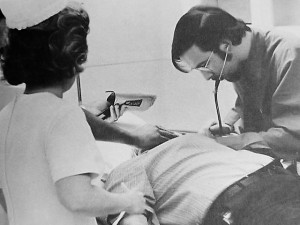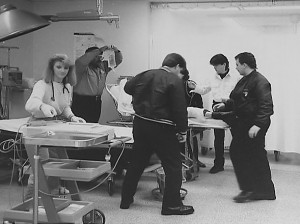This story is the seventh of a multi-part series on the history of the Health Center. The entire series can be read at the Health Center’s 50th Anniversary website.

Over the years, the University of Connecticut Health Center has been instrumental in enhancing clinical care in the state through the John Dempsey Hospital and its outpatient practice, the UConn Medical Group, which is now the largest multispecialty practice in the Hartford region with more than 450 experts. Clinical services also include outstanding dental care through University Dentists, the Center for Implant and Reconstructive Dentistry and other dental services.
“There was always a good quality of medicine in the Hartford area, lots of talent, but the University filled in and created areas of strength that hadn’t existed before.” says former Associate Dean Hinz.
One of its earliest achievements was the development of the Neonatal Intensive Care Unit, or NICU.
“This University helped to set the standard of care in neonatal intensive care,” says Hinz.
“The NICU was always an important program for the hospital,” says Jeanne Lattanzio who came to UConn in 1971 and oversaw the NICU in her role as director of critical care. “We had a Level 3 NICU. Our vans went to other hospitals to bring babies here. When people thought about Dempsey, they’d think about the NICU. And they still deliver incredible care here.”
It is expected that the NICU at the UConn Health Center will soon join forces with Connecticut Children’s Medical Center, in an effort to enhance research and education opportunities in the field of neonatology. This move will be tied to efforts to expand the adult medical-surgical bed count at the Health Center.
Dr. Jack Blechner, joined the Health Center in 1970 to start its Department of Obstetrics and Gynecology. He chaired the department until 1999, becoming the longest-seated chairman of OB/GYN in the country. Under his leadership, UConn significantly expanded the specialty care available to women in the state.
“We developed subspecialty services that were needed in this general community,” says Blechner. Those services were High-Risk Obstetrics (now Maternal-Fetal Medicine, focused on caring for pregnant women with medical complications); Reproductive Endocrinology and Infertility (including a now-prominent in vitro fertilization program); and Gynecologic Oncology (cancers of the female reproductive system). Dr. Blechner and his colleagues went on to develop residencies in these areas and fellowships in Maternal-Fetal Medicine and Reproductive Endocrinology and Infertility. Many UConn graduates chose to enter these subspecialties.

The OB/GYN Department developed a regional program focused on high-risk obstetrics. Through this program, they provided education and consultation to 17 hospitals in the northern tier of the state to ensure that all pregnant women with health issues could benefit from the current best practices in the field. In the late 1970s, in an innovation that was well ahead of its time, the department developed a system whereby fetal monitoring data was sent electronically in real time from community hospitals to the Health Center. There, fellows and physicians with advanced expertise in maternal-fetal health were on call around the clock to review the data and provide advice to the community physician at the patient’s bedside.
“We could see exactly what the physician saw,” says Blechner. “There were probably not many places that were doing this.”
Clinical Care Fast Facts
- One and Only – The Health Center is home to the Farmington Valley’s only full-service 24/7 Emergency Department.
- One and Only – The Health Center is home to Connecticut’s only TomoTherapy radiation oncology system.
- 28,891 patient visits were made to John Dempsey Hospital’s Emergency Department in 2010.
- 284,337 outpatient visits were made to John Dempsey Hospital in 2010.
- 9,513 patients were admitted to John Dempsey Hospital in 2010.
- 138,658 patient visits were made to the School of Dental Medicine’s Farmington clinics and affiliated community sites in 2010.
The department also shared its members’ expertise by publishing suggested protocols for physicians to use in caring for women with medical conditions that complicated pregnancy.
Today, the University’s residency program in obstetrics and gynecology has 40 residents, making it one of the largest OB/GYN residency programs in the country.
Although the Health Center always provided clinical care, its primary focus was on education and research until the last 20 years or so, says Peter Deckers, former dean of the medical school.
“In the past 25 years a radical change occurred, allowing the development of especially strong clinical programs in neuroscience, neurology, neurosurgery, cardiovascular medicine, adult oncology, musculoskeletal medicine and surgery,” Deckers says. This change, he says, has come about largely because of the economic realities of today’s health care environment.
“If you don’t compete in the clinical domain, you don’t have sufficient control of the student educational product, and you don’t have access to the profitability of the clinical domain to support academics throughout the institution,” Dr. Deckers says. “We have found it necessary over the last 15 years to be very competitive on the clinical side. We would like to expand the number of beds here because we have an ideal location and an ideal faculty that can care for patients expertly.”


